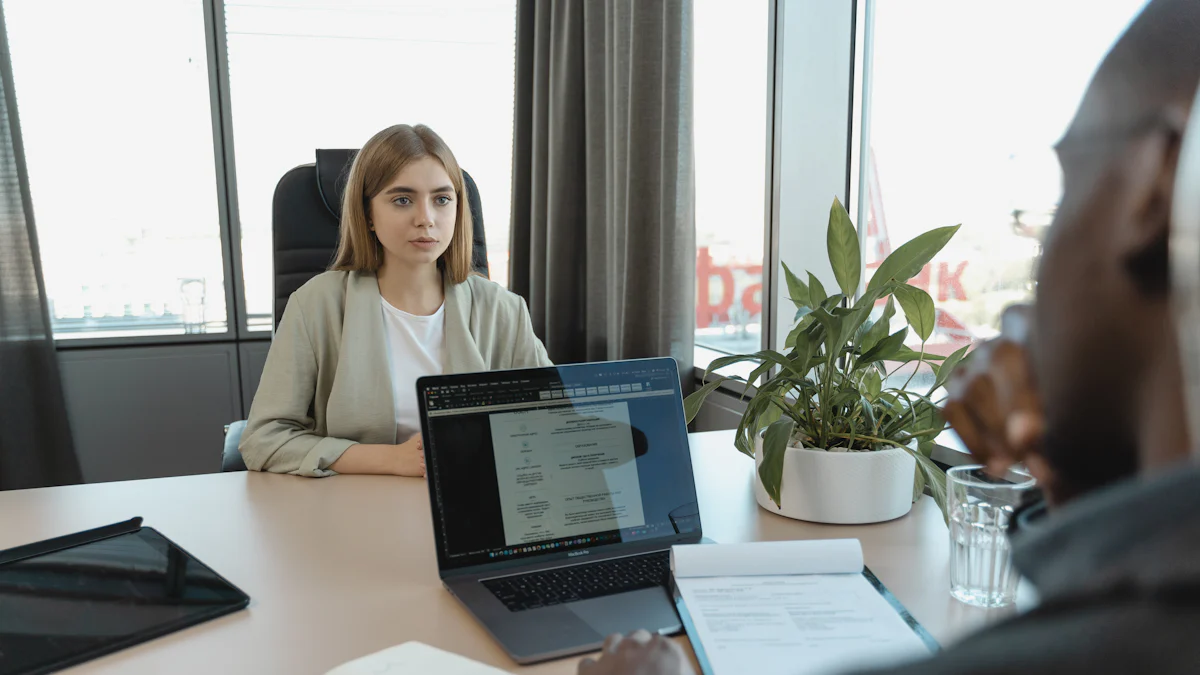Step-by-Step Guide to Conducting a Five-Act Interview
Try Aihirely for
Smarter Interview Prep
Experience real-time AI support tailored to your Resume.
Boost your confidence and ace every question with
AI Mock Interview.

Image Source: pexels
A five-act interview is a structured method for user testing that helps you uncover valuable insights about your product. It’s designed to guide users through a series of steps, starting with making them feel at ease and ending with a quick debrief. This approach ensures you get honest feedback while keeping the process smooth and organized.
Here’s what makes it stand out: You begin by creating a comfortable environment for participants. Then, you ask context questions to learn about their habits. Next, you introduce the prototype and let them explore it while thinking out loud. Finally, you guide them through tasks and wrap up with a short discussion. This structure makes it easier to spot patterns and improve your product.
If you’ve been wondering how to conduct a five act interview effectively, this method gives you a clear roadmap to follow.
Key Takeaways
-
Decide on clear goals to stay focused during the interview.
-
Choose participants who match your audience for useful feedback.
-
Make participants feel at ease to get honest answers.
-
Use the five-act process to guide the interview smoothly.
-
Study and sort results to find patterns and improve your product.
Preparing for the Interview

Image Source: pexels
Setting Clear Goals
Before diving into the interview process, you need to set clear goals. This step ensures you know exactly what you want to achieve. Here’s how you can do it:
-
Start by defining the purpose of your research. Are you testing usability, identifying pain points, or exploring user behavior?
-
Involve key stakeholders. Their input can help you create a well-rounded objective.
-
Align your interview questions with your research goals. This keeps the conversation focused and productive.
When you have a clear roadmap, it’s easier to stay on track and get meaningful insights. Plus, it helps you avoid wasting time on irrelevant details.
Recruiting the Right Participants
Finding the right participants is crucial for a successful interview. You want people who represent your target audience. Here’s what to consider:
-
Define key characteristics like age, occupation, and interests.
-
Think about how your product will be used. For example, if it’s a fitness app, look for users who are into health and wellness.
-
Use feedback from existing customers to understand their needs and demographics.
Creating user personas can also help. These profiles give you a clear picture of your ideal participant, making recruitment much easier.
Preparing Materials and Tools
Preparation is key when learning how to conduct a five act interview. Make sure you have everything ready before the session starts. Here’s a quick checklist:
-
Video-conferencing software if you’re conducting the interview remotely.
-
A webcam and microphone to ensure clear communication.
Having the right tools in place helps the interview run smoothly. It also shows participants that you’re organized and professional, which can make them feel more comfortable.
How to Conduct a Five-Act Interview
Act 1: Friendly Welcome
Start your interview with a warm and friendly introduction. This step sets the tone for the entire session and helps participants feel at ease. Greet them with a smile and thank them for taking the time to join. Briefly explain what user testing is and why it’s important. For example, you might say, “We’re testing the prototype to see how it works for users like you. There are no right or wrong answers—your honest feedback is what matters most.”
Make sure to clarify that the session is about the product, not the participant. This reassurance can reduce any anxiety they might feel. A relaxed participant is more likely to provide genuine insights, so take a moment to build rapport before diving into the next steps.
Act 2: Context Questions
Once the participant feels comfortable, shift the focus to context questions. These questions help you understand their background, habits, and experiences. Start broad and gradually narrow the scope to align with the prototype. For instance, if you’re testing a fitness app, you could begin by asking, “What’s your typical workout routine?” and then move to, “Have you used any fitness apps before?”
This part of the interview is all about listening. Let the participant share their story without interruptions. Their answers will give you valuable context and help you interpret their feedback later. Plus, it’s a great way to transition smoothly into the prototype introduction.
Act 3: Introduction to the Prototype
Now it’s time to introduce the prototype. Keep your explanation neutral to avoid influencing the participant’s opinions. Let them know the prototype might have flaws and that their feedback will help improve it. For example, you could say, “This is an early version of the product, so some things might not work perfectly. We’re here to learn from your experience.”
Encourage them to think out loud as they interact with the prototype. This approach gives you a window into their thought process, helping you uncover usability issues or areas of confusion. Avoid leading them with specific instructions. Instead, let them explore naturally while you observe and take notes.
By following these steps, you’ll create a smooth and engaging experience for your participants. This structure is key to mastering how to conduct a five act interview effectively.
Act 4: Tasks
This is where the real action happens. You’ll guide participants through specific tasks to see how they interact with your prototype. These tasks should mimic real-world scenarios so you can observe how users would naturally use your product.
Start by giving clear instructions for each task. For example, if you’re testing an e-commerce website, you might say, “Imagine you’re shopping for a gift. Find a product, add it to your cart, and proceed to checkout.” Keep your instructions simple and avoid leading the participant toward a specific outcome.
While they work through the tasks, pay close attention to their behavior. Are they hesitating? Do they seem confused? These moments can reveal usability issues. Encourage them to think out loud as they go. You might say, “Feel free to share what you’re thinking as you complete this step.” Their thoughts can give you valuable insights into their decision-making process.
Take notes, but don’t interrupt unless absolutely necessary. If they get stuck, let them try to figure it out on their own. This struggle can highlight areas where your design needs improvement.
Remember, the goal here isn’t to test the participant’s skills. It’s to understand how your product performs in real-world situations. By the end of this act, you’ll have a clearer picture of what’s working and what needs fixing.
Act 5: Quick Debrief
Wrap up the session with a quick debrief. This step gives participants a chance to share any final thoughts or feedback. It also helps you clarify anything you didn’t fully understand during the tasks.
Start by thanking them for their time and effort. Then, ask open-ended questions like, “How did you feel about the experience?” or “Is there anything you’d like to add that we didn’t cover?” These questions can uncover insights you might have missed earlier.
Keep the debrief short and focused. You don’t want to overwhelm participants after they’ve already spent time testing your prototype. A five-minute conversation is usually enough to gather additional feedback and end the session on a positive note.
Finally, let them know what happens next. For example, you could say, “We’ll use your feedback to improve the product. Thanks again for helping us make it better!” This leaves participants feeling valued and appreciated.
By mastering these steps, you’ll know exactly how to conduct a five act interview from start to finish. Each act builds on the last, creating a seamless process that delivers actionable insights.
Best Practices for a Successful Interview
Making Participants Comfortable
Creating a comfortable environment is essential for a successful interview. When participants feel at ease, they’re more likely to share honest and valuable feedback. Here’s how you can make that happen:
-
Set up a welcoming space, whether in person or online. Ensure the environment feels safe and distraction-free.
-
Pay attention to your body language. Stay relaxed and approachable to help participants feel the same.
-
Start with small talk. A casual conversation can break the ice and build rapport.
-
Always ask for permission before starting. This shows respect and sets a positive tone.
-
Assure participants of confidentiality. Knowing their responses are private builds trust.
-
Offer breaks if needed. This gives them time to gather their thoughts.
When you begin, introduce yourself and explain the purpose of the interview. Let them know there are no right or wrong answers. Start with easy questions to ease them into the session. Avoid rushing or interrupting them. A calm and patient approach goes a long way in making participants feel valued.
Avoiding Leading Questions
Leading questions can skew your results and make feedback less reliable. To get honest insights, avoid questions that push participants toward a specific answer. For example:
-
“How much do you enjoy [product]?”
-
“Our previous feedback survey showed most people prefer breakfast as their favorite meal. Do you agree?”
-
“How satisfied or dissatisfied are you with the customer experience?”
Instead, ask open-ended questions like, “What are your thoughts on this feature?” or “How would you describe your experience using this product?” Neutral phrasing encourages participants to share their genuine opinions.
Taking Effective Notes
Good note-taking helps you capture key insights without losing focus during the interview. Here are some tips:
-
Don’t try to write down everything. Focus on important points and memorable quotes.
-
Listen carefully for key moments that highlight user behavior or pain points.
-
If you miss something, don’t hesitate to ask the participant to repeat it.
-
Accuracy matters, but don’t stress over minor details.
By staying present and jotting down the essentials, you’ll have a clear record of the session to analyze later.
Managing Time During the Interview
Time management can make or break your five-act interview. You want to stay on track without rushing participants or cutting corners. Here are some practical tips to help you manage time effectively:
-
Set time limits for each act: Before the session, decide how much time you’ll spend on each part of the interview. For example, allocate 5 minutes for the friendly welcome, 10 minutes for context questions, and so on. Stick to these limits to ensure you cover everything.
-
Slow things down when needed: If a participant moves too quickly through a task, ask them to pause and explain their thought process. This gives you deeper insights and keeps the session balanced.
-
Use natural pauses for discussion: Introduce moments like ‘waiting’ screens or transitions between tasks. These pauses create opportunities to ask follow-up questions or clarify user expectations.
Tip: Keep a timer handy, but don’t let it dominate the session. Use it as a guide, not a strict rule.
Another great way to save time is by using tools like online scorecards. These let you capture real-time feedback without juggling sticky notes or scribbling on paper. Plus, they keep your notes organized and easy to review later.
Finally, wrap up with a quick debrief. Spend 5 minutes asking open-ended questions to gather final thoughts. This ensures you don’t miss any last-minute insights while respecting the participant’s time.
Managing time well keeps your interview smooth and productive. It also shows participants that you value their time, which helps build trust and encourages honest feedback.
Analyzing and Using Results

Image Source: pexels
Organizing Your Findings
After completing your five-act interviews, you’ll likely have a lot of raw data. Organizing it is the first step to making sense of everything. Start by reviewing your notes and recordings. Highlight key moments where participants struggled, hesitated, or shared strong opinions. Group similar observations together to create categories.
Using a spreadsheet or a digital tool can help you stay organized. For example, you can create columns for participant feedback, usability issues, and suggested improvements. This structure makes it easier to spot trends later. If you recorded the sessions, consider transcribing them. While it takes time, having a written record allows you to revisit details you might have missed during the interview.
Identifying Patterns and Insights
Once your findings are organized, it’s time to dig deeper. Look for patterns that reveal how users interact with your product. Here are some effective methods:
-
Use thematic analysis to identify recurring themes in the feedback.
-
Segment your data by user type or behavior to uncover unique perspectives.
-
Combine insights from interviews with other data sources, like surveys or heatmaps, for a more complete picture.
For example, if multiple participants struggled with the same feature, that’s a clear sign it needs improvement. On the other hand, if they all praised a specific aspect, you know it’s working well. Tools like heatmaps can also show where users focus their attention, which you can compare with their verbal feedback.
Applying Feedback to Improve the Product
Now comes the exciting part—turning feedback into action. Start by asking yourself a few key questions: What surprised you about the feedback? What were the biggest strengths and weaknesses of the prototype? If you could change one thing, what would it be?
Next, prioritize the changes based on their impact and feasibility. Focus on fixing major usability issues first. For example, if users couldn’t complete a critical task, that should be your top priority. After addressing the big problems, move on to smaller tweaks that enhance the overall experience.
Always keep your users in mind. Their feedback is your guide to creating a product that truly meets their needs. By following these steps, you’ll not only improve your prototype but also gain a deeper understanding of how to conduct a five act interview effectively.
The five-act interview gives you a clear, structured way to gather meaningful user feedback. Each step, from the friendly welcome to the quick debrief, plays a role in uncovering insights. Slowing users down to share their expectations and asking follow-up questions helps you understand their preferences better. Wrapping up with a debrief captures final reflections that can guide design improvements. This method doesn’t just test your product—it helps you create a better experience. Start applying it in your user testing today and see how it transforms your design process!
FAQ
What is the main goal of a five-act interview?
The main goal is to gather actionable insights about how users interact with your product. It helps you identify usability issues, understand user behavior, and improve the overall experience based on real feedback.
How long does a five-act interview usually take?
A typical session lasts 30-60 minutes. This includes time for the friendly welcome, context questions, tasks, and a quick debrief. Keeping it concise ensures participants stay engaged and focused.
Do I need a fully developed product to conduct a five-act interview?
No, you don’t. You can test a prototype, wireframe, or even a concept. The goal is to learn how users interact with your design, regardless of its development stage.
Can I conduct a five-act interview remotely?
Absolutely! Use tools like Zoom or Google Meet for video calls. Share your prototype through screen-sharing or interactive links. Just ensure your setup allows clear communication and smooth interaction with the prototype.
What should I do if a participant struggles with a task?
Let them try to figure it out without intervening. Their struggle can reveal design flaws. If they get stuck, ask open-ended questions like, “What are you expecting to happen here?” This helps you understand their thought process.
Tip: Always encourage participants to think out loud. It gives you deeper insights into their experience.
